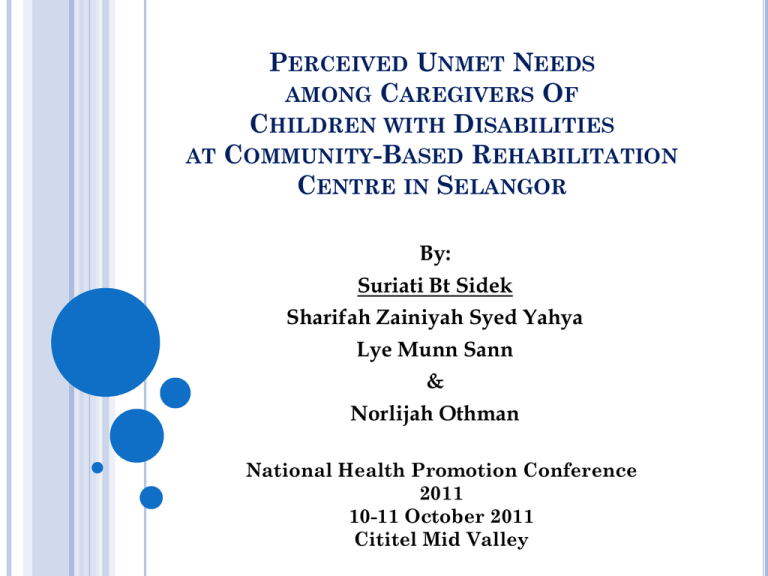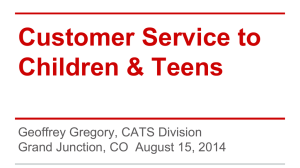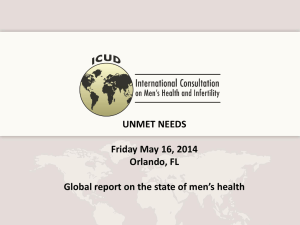PERCEIVED UNMET NEEDS AMONG CAREGIVERS OF
advertisement

PERCEIVED UNMET NEEDS AMONG CAREGIVERS OF CHILDREN WITH DISABILITIES AT COMMUNITY-BASED REHABILITATION CENTRE IN SELANGOR By: Suriati Bt Sidek Sharifah Zainiyah Syed Yahya Lye Munn Sann & Norlijah Othman National Health Promotion Conference 2011 10-11 October 2011 Cititel Mid Valley INTRODUCTION Disability is covering impairments, activity limitations and participation restrictions (World Health Organization, 2009a). There are seven categories of disabilities; which include hearing, visual, physical, speech, learning, mental and multiple disabilities (Community Portal for Disabled People, 2009). Statistic Report (2009) shows that there are 261 154 disabled people had registered with the Social Welfare Department of Malaysia. PROBLEM STATEMENT Improvement on healthcare system increases life expectancy of children with disabilities (Martin and Colbert, 1997). Caregivers may experience the need for: Information Social support A range of services Financial support (Bailey and Simeonsson, 1988; Graves and Hayes, 1996; Farmer et al., 2004;). OBJECTIVES General: To determine the perceived unmet needs among caregivers of children with disabilities at Communitybased Rehabilitation centre (CBR) in Selangor. Specific: To determine the caregivers’ socio-demographic characteristics and children’s demographic characteristics. 2. To determine the type and frequency of unmet needs of caregivers of children with disabilities according to the six subscales using the Family Need Survey (FNS) instrument. 1. METHODOLOGY Study Design Cross-sectional Study Location 12 selected CBR centres in Selangor. Study Population Caregivers of children with disabilities who registered with the CBR centre. Sampling Frame The list of districts in Selangor. Sampling Unit The primary sampling unit in this study is the district in Selangor. Sampling Method A simple one-stage cluster sampling Sample Size 337 participants Data Collection Method Assisted self-administered questionnaire and face to face interview. MATERIAL Scale Authors Item Reliability Family Needs Survey (FNS) Bailey and 6 subscales KuderSimeonsson with 35 Richardson 20 = (1988) items 0.88. Validity A good content and construct validity DATA ANALYSIS Statistical Test Purpose Descriptive To determine the frequency distribution and percentage. RESPONSE RATE Table 1 Distribution of response rate according to the districts District KUALA LANGAT Suboverall HULU LANGAT Name of CBR centre Number of eligible caregivers Telok Datok Rumah SayangKu Tanjung Sepat Bukit Changgang Semenyih Taman Seri Jerlok Suboverall KLANG Suboverall KUALA SELANGOR Suboverall SEPANG GRAND OVERALL Klang Utara Klang Selatan Sri Cahaya Kuala Selangor Tanjung Karang Rumah Impianku % of respon se rate 52 33 Number of recruited caregiver s 49 29 22 16 18 15 81.8 93.8 123 28 50 111 25 44 90.2 89.3 88.0 78 30 31 61 25 15 20 69 25 28 53 21 9 15 88.5 83.3 90.3 86.9 84.0 60.0 75.0 60 15 45 10 75.0 66.7 337 288 85.5 94.2 87.9 288 of caregivers participated in the study (85.5%). The response rate in each of the district ranged from 66.7% to 90.2%. CAREGIVERS’ SOCIO-DEMOGRAPHIC CHARACTERISTICS Table 2 Caregivers’ socio-demographic characteristics (n=288) Characteristics Relationship Mother Others Gender Male Female Race Chinese Indian Malay Marital Status Married Divorced Occupation Government servant Private sector Self-employed Housewife Family Monthly Income ≤ RM1000 RM 1001-2000 RM 2001-3000 >RM 3000 No. of Children 1-4 5-9 ≥10 Education Level No education Primary Secondary Tertiary Place of Residence Rural Urban Frequency (n) Percentage (%) 280 8 97.2 2.8 0 288 0 100 32 28 228 11.1 9.7 79.2 286 2 99.3 0.7 43 24 12 209 14.9 8.3 4.2 72.6 106 102 37 43 36.8 35.4 12.8 14.9 195 89 4 67.7 30.9 1.4 2 39 196 51 0.7 13.5 68.1 17.7 181 107 62.8 37.2 Majority of respondents were: Mothers (97.2%) Malay (79.2%) Married (99.3%) Housewives (72.6%) Resided in rural area (62.8%) Majority of respondents had: Some form of education (99.3%) Monthly income of below RM 2000 (72.2%). Less than four children (67.7%) CHILDREN’S DEMOGRAPHIC CHARACTERISTICS Table 3 Children’s demographic characteristics (n=288) Characteristics Gender Male Female Age (years) <0 1-4 5-9 10-14 15-17 Type of Disability Hearing Visual Physical Mental Speech Learning Multiple Disabilities Frequency (n) Percentage (%) 169 119 58.7 41.3 1 44 142 70 31 0.3 15.3 49.3 24.3 10.8 3 1 66 0 2 154 62 1.0 0.4 22.9 0.0 0.7 53.5 21.5 More than half of the respondents have: Male children (58.7%). Children with learning disability (53.5%). Children aged below ten years old (64.9%). Distribution of the Type and Frequency of Unmet Needs among Caregivers Table 4 Unmet needs reported by caregivers (n=288) Type of Need Respondent with unmet needs n (%) Information 1 Information about my child’s condition or disability 2 Information about how to handle my child’s behavior 3 Information about how to teach my child 4 Information on how to play with or talk to my child 5 Information on the services that are presently available 6 Information about the services my child might receive in the future 232 (80.6) 233 (80.9) 254 (88.2) 227 (78.8) 244 (84.7) 272 (94.4) 7 266 (92.4) Information about how children grow and develop Table 4 (Continued) Unmet needs reported by caregivers (n=288) Type of Need Respondent with unmet needs n (%) Community Services 21 Locating a doctor who understands me and my child’s needs 172 (59.7) 22 Locating a dentist who will see my child 174 (60.4) 23 Locating babysitters or respite care providers who are willing and able to care for my child 78 (27.1) 24 25 Locating a day care center or preschool for my child Getting appropriate care for my child during religious activity 166 (57.6) 99 (34.4) Financial Support Support 8 9 10 11 12 Someone in my family that I can talk to more about problems More friends that I can talk to More opportunities to meet and talk with other parents More time just to talk with my child’s teacher or therapist Meet more regularly with a counselor (psychologist, social worker, psychiatrist) to talk about problems 182 (63.2) 199 (69.1) 213 (74.0) 217 (75.3) 162 (56.2) 13 Talk more to a minister who could help me deal with problems 130 (45.1) 14 Reading material about other parents who have a child similar to mine 220 (76.4) 15 More time for myself 131 (45.5) Explaining to Others 16 17 How to explain my child’s condition to his or her siblings Explaining my child’s condition to either my spouse or my spouse’s parents 81 (28.1) 68 (23.6) 18 My spouse needs help in understanding and accepting our child’s condition 69 (24.0) 19 How to respond when friends, neighbors, or strangers ask questions about my child’s condition 80 (27.8) 20 Explaining my child’s condition to other children 94 (32.6) 26 27 28 29 30 31 Paying for expenses such as food Getting special equipment for my child’s needs Paying for therapy, daycare, or other services my child needs More counseling or help in getting a job Paying for babysitting or respite care Paying for toys that my child needs 190 (66.0) 155 (53.8) 117 (40.6) 47 (16.3) 83 (28.8) 115 (39.9) Family Functioning 32 33 34 Discussing problems and reaching solutions Learning how to support each other during difficult times Deciding who will do household chores, child care, and other family tasks 100 (34.7) 128 (44.4) 69 (24.0) 35 Deciding on and doing recreational activities 106 (36.8) PERCEIVED UNMET NEEDS Highest -> Need for information of services that the child might receive in the future (94.4%) and ways to promote child growth and development (92.4%). Supported by other studies: Bailey and Simeonsson (1988) and Farmer et al., (2004). The mean score of the overall unmet needs was 18.67 (±SD 7.623). Table 5 Descriptive analysis of unmet needs in each subscale According to subscale: Subscale Information Support Community Services Financial Family Functioning Explaining to Others % of Caregivers with Unmet Needs 98.3 93.4 84.0 79.9 61.8 46.2 PERCEIVED UNMET NEEDS These Issues related to information about services becomes more important as the child gets older. findings show that: Explanation: caregivers concern and worry about the ongoing care for the child in the future, especially if the caregivers pass away (Lam and Mackenzie, 2002). Need for information remains largely unmet Explanation: caregivers failed to get help and have no idea where to acquire the information needed (Sloper and Turner, 1992). CONCLUSION The unmet needs among caregivers were varied. More effective intervention programs are needed in CBR centre to match or reduce those varied unmet needs. RECOMMENDATION The provision of information should be optimized. Information should be delivered in several ways. REFERENCES Bailey, D. B. & Simeonsson, R. J. (1988). Assessing needs of families with handicapped infants. The Journal of Special Education. 22(1), 117-127. Community Portal for Disabled People (2009). Categories of diabilities. Retrieved on August 20, 2009 from http//www.pakarunding.ukm.my/komunitikita/OKU/details.asp?ID=36. Farmer, J.E., Marien, W.E., Clark, M.J., Sherman, A. & Selva, T.J. (2004). Primary care supports for children with chronic health conditions: Identifying and predicting unmet family needs. Journal of Pediatric Psychology. 29(5), 355-367. Graves, C. & Hayes, V.E. (1996). Do nurses and parents of children with chronic conditions agree on parental needs? Journal of Pediatric Nursing. 11(5), 288-299. Lam, L.W. & Mackenzie, A.E. (2002). Coping with a child with Down syndrome: The experiences of mothers in Hong Kong. Qualitative Health Research. 12(2), 223-237. Martin, C.A. & Colbert, K.K. (1997). Parenting : A life span perspective. Parenting children with special needs (pp. 257-281). United States of America: The McGraw-Hill Companies, Inc. Sloper, P. & Tuner, S. (1992). Service needs of families of children with severe physical disability. Child: Care, Health and Development. 18, 259-282. Statistic Report (2009). Disabled People. Statistic of Social Welfare Department of Malaysia. Social Welfare Department of Malaysia, Ministry of Women, Family and Community Development. Warfield, M.E. & Gulley, S. (2006). Unmet needs and problems accessing specialty medical and related services among children with special health care needs. Maternal and Child Health Journal, 10(2), 201-216. World Health Organization (2009a). Disabilities. Retrieved on 3 July, 2009 from http://www.who.int/topics/disabilities/en/








